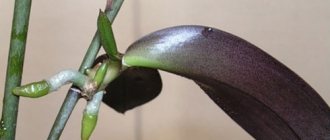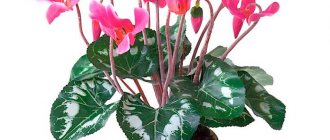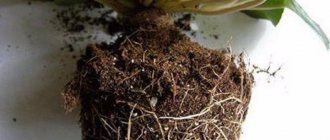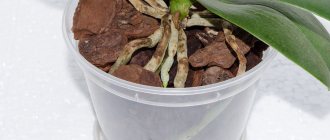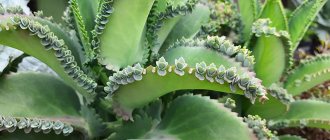Reasons why a transplant is needed
A transplant may be needed in the following cases:
- It is worth replanting a flower if its tuber takes up a lot of space in the pot and the roots have nowhere to grow.
- It is also necessary after purchase, but not immediately, but after several months. The pots in which the flower is sold are too small, so you need to choose a larger container so that the root system can continue to develop unhindered. Read our article about the rules for caring for cyclamen after purchase.
- If a flower was purchased, then you need to know that the land in which it grows is very poor. Immediately after the cyclamen fades, it is replanted. In the case of good soil in a purchased pot, the plant can be left untouched for a whole year.
- Experienced flower growers recommend replanting regularly. This needs to be done once every few years.
Answers to user questions
Let's look at how to correctly divide cyclamen into several full-fledged flowers, and also find out whether it is necessary to replant immediately after acquisition, and whether this can be done when flowering occurs.
How to divide cyclamen when transplanting?
When a flower grows, it needs to be divided. This can be done at the last stage of dormancy, before the flower wakes up.
Let's look at how to properly divide a plant:
- the tuber is taken out and dried;
- inspect, choosing the place of separation;
- use a sharp knife to make the required number of cuts;
- bare areas are sprinkled with activated carbon and left for a day in the dark;
- planted in new pots.
The correctness of the actions is confirmed by flowering after 6 months.
Did you know? In an 18th century book, cyclamen is called “pig’s bread” because pigs love to feast on the tubers of this plant and often tear up the ground in search of them.
Do I need to replant after purchase?
After acquisition, cyclamen is replanted in the absence of flowering, and also if the flower is in transport soil, which contains little fertilizer and does not retain moisture well. If flowers are present, it is recommended to wait for a dormant period.
When to perform the procedure?
Important! Transplantation is carried out after the plant comes out of the dormant period, that is, at the end of July or beginning of August. This procedure must be done before the buds appear.
The end of the dormant period can be determined by the formation of young leaves.
The time of transplantation also depends on the type of cyclamen. For example, European cyclamen does not have a pronounced dormant state and remains green all the time. It begins to bloom in mid or late May. If you do a transplant, it will be until then. It is best to carry out the procedure in March.
You should behave completely differently with Persian cyclamen. Every year he experiences a state of rest. It begins in the middle of winter and lasts until the end of summer. In June-August, young leaves begin to hatch, it is during this period that replanting should be done.
Replanting after purchase
It is not recommended to feed or replant within 2-3 months after purchase . Since the amena usually purchased in bloom, you must first wait for the end of flowering and only then replant. The golden rule of indoor floriculture: do not replant flowering plants.
As soon as the Persian cyclamens have bloomed, you can take care of replanting. And it may be needed in the following cases:
Photo
Below you can see a photo of the flower:
Varieties of cyclamen
Soil for avocado: how to plant a seed correctly and how to replant a sprouted one
There are not many varieties of cyclamen, there are only two. The indoor flower is very beautiful and popular among gardeners, since it is not difficult to grow, and cyclamen is unpretentious in care. But let's take a closer look at the European and Persian varieties. Let's find out what the differences and similarities are between these two types.
European species of cyclamen
The European type of cyclamen, or, as it is also called, “purple,” includes several subspecies: purple, ivy and notched.
European cyclamen is a perennial plant that has a flat tuber with a diameter of 10 centimeters. A characteristic feature by which one can recognize the European species of the plant is the tuber, which is flattened on all sides. The leaves of the European species are long and extend from the root. The color of the leaves may vary. But most often the leaves are soft green with silver inclusions. Cyclamen can also be recognized by its leaf blade: it is heart-shaped and the edges are slightly pointed. You can see a photo of European cyclamen below.
Cyclamen blooms from summer to October, its peduncles are quite long, and the flowers have five oval petals twisted into a spiral. The color scheme can vary from lilac tones to purple.
In addition to the fact that cyclamen is a beautiful flower, it is also useful, as it is a powerful antiseptic and can be used to treat viral infections in the body.
Persian view
The Persian species of cyclamen, or “alpine violet,” is a perennial herbaceous plant that reaches a height of 30 centimeters. The tubers are even larger than the European ones - 15 centimeters. The leaves are basal, heart-shaped and variegated in color. The peduncles are the same larger (15-20 centimeters) as those of the European species. But the color range of this representative is wider than that of the European one. There are white, pink, scarlet, lilac, violet and lilac shades of flowers. During the flowering period, up to 100 flowers can bloom on one flower. You can see a photo of the Persian cyclamen below.
Persian cyclamen blooms in autumn or winter. The duration of flowering depends on the variety and the care of the flower.
Regardless of the type, dividing a flower is possible in several ways, which we will discuss below. You should carefully read the information, as each method has certain differences.
Preparation for the procedure
Container size
Cyclamen does not do well in large pots. The container is selected taking into account the size of the plant’s rhizome:
- A pot with a diameter of 7-8 centimeters is perfect for a young tuber between one and a half years old.
- Older tubers (2-3 years) need containers with a diameter of 15-16 centimeters.
Reference. The distance from the tuber to the edge of the pot should be 2-3 centimeters.
Priming
A lot depends on the soil, especially the condition of the cyclamen itself, the activity of growth and flowering. Ideally, the soil mixture for cyclamen should be loose and nutritious. Loose soil is the main condition for successful flower growth. Often they buy a ready-made mixture at flower shops. But it's better to do it yourself. For this you will need:
- One part peat.
- Humus is one part.
- Clean sand, also one part.
- Leaf soil - three parts.
In order for roots to form better and the plant to take root better, a little vermiculite is added to the ground. Before planting, the soil must be watered with a weak solution of potassium permanganate. This procedure is necessary to kill fungal pathogens.
How to replant Persian cyclamen:
First transplant in spring after flowering. Fresh soil mixture is required. Either buy ready-made (they recommend the “Tulip” mixture), or prepare it yourself. Take 3 parts of leaf soil and 1 part each of humus, peat and sand. The soil mixture is steamed and spilled with a pink solution of manganese. Do not neglect soil disinfection, since cyclamens are easily attacked by pests. The plant is provided with drainage. The transplanted cyclamen can be placed on the window, where it will spend the whole summer.
Repeated transplantation of Persian cyclamen. At the beginning of September, before flowering, the pot needs to be inspected: if the soil is densely entwined with roots, you can replant it. The plant, along with the roots and a lump of earth, is transferred into a larger pot. If the plant does not require replanting, the upper part of the tuber is simply cleared of soil and the plant is placed in a bright, cool place. Soon cyclamen will bloom and enliven your windowsill in the gloomy autumn.
Attention! When replanting, under no circumstances should the Persian cyclamen tuber be buried. It should rise 1/3 above the surface of the earth (unlike European cyclamen), and 2/3 of the tuber should sit in the ground.
Step by step process instructions
How to transplant homemade cyclamen into another pot - step by step:
Prepare the substrate.- Prepare a new container; if you use an old one, be sure to treat it with potassium permanganate or pour boiling water over it, this is done for disinfection.
- Carefully remove yellowed and dry leaves.
- Carefully remove the plant from the pot and inspect the bulb and roots.
- Dry and rotten roots should be trimmed with clean scissors.
- Since the transplant is carried out into new fresh soil, it is necessary to remove the old soil from the roots as much as possible.
- Next, drainage is poured onto the bottom of the pot and 3-4 centimeters of soil is added.
- Place the flower and add more soil, but do not cover the entire bulb. It should be visible.
- Water the cyclamen thoroughly, but do not get water on the center of the tuber. Drain excess water from the pan.
- Then the flower is put back in place and left alone.
The subtleties of planting in a pot
- It is recommended to replant cyclamens directly with a clod of earth, without disturbing the roots.
- It is useful to pour expanded clay onto the bottom of the pot for drainage, then lay a layer of soil mixture. After this, the tuber is lowered into the pot along with a lump of earth and soil is added so much so that the tuber remains sticking out 1/3 above the surface of the earth. After planting, squeeze the soil with your hands.
- 30 days after transplantation, cyclamen requires feeding. Ready-made liquid mixtures are best suited for this.
- During flowering, it is useful to feed cyclamens regularly: once a month (until they bloom).
How to divide a flower correctly?
On a note. Flower division can be done in two ways - tubers and rosettes.
Tubers:
- The first step is to take out the onion and dry it.
- Afterwards, cut into pieces and leave each piece with a bud and a few roots.
- Then we leave it in a dark place to dry the cut.
- When the tuber is planted, the pot is removed away from direct rays.
Sockets:
- To begin with, a shoot is torn off from the tuber and planted in damp soil.
- Next, place the flower under a transparent film.
- After a few weeks, the rosettes will develop roots.
- Be sure to observe the temperature regime.
- Subsequent care is no different from caring for an adult flower.
These and other methods of propagating cyclamen are discussed in more detail in a separate article.
Peculiarities
Cyclamen has more than 20 varieties within its genus. The differences between them are that each species has its own color or differs from its counterpart in the structure of the flower - there are even flowers with a double structure. In addition, the size of the flower also varies depending on the type of plant: this exotic beauty grows from 15 to 30-35 centimeters in height.
Cyclamen is a perennial; all its modern varietal hybrids were obtained from Persian and European cyclamen species. These are the species that experts recommend for home breeding.
With proper care, Persian cyclamen can grow up to 30 cm in height. Outwardly, it is very attractive, it has dark green leaves with a light green edging, and large flowers have rich pink shades.
European cyclamen also has dark green leaves, but the pattern on them is not as contrasting as that of the Persian species. The flowers of the European variety are smaller in size, but they are much brighter in color. European cyclamen has a peculiarity - it does not have a winter dormant phase, which means it will be much easier to care for.
The root system of cyclamen is tuberous; there are dormant buds on it, from which leaves sprout, collecting in a rosette. In the center of the tuber there are growth points for future flower stalks. Growing up, these flower stalks rise above the foliage. Flowers on peduncles grow with a downward slope, and their petals bend upward. Each flower has both a pistil and a stamen, that is, it is a hermaphrodite.
The annual life cycle of the plant is unique and occurs in three conventional phases. The flower grows in the autumn months, blooms in the winter, and in the spring and summer the plant is in a state of rest.
Care
Basic requirements and rules for caring for cyclamen at home:
Lighting and temperature. Cyclamen responds positively to coolness and bright, diffused light. There is no need to place cyclamen under the scorching sun. It will feel best on the western or eastern side. Suitable temperature +10+18 degrees.- Watering. During the growth period, the soil should be sufficiently moistened, but do not overfill the flower with water.
We must rememberthat moist air is beneficial for cyclamen.Immediately after transplantation, there is no need to overwater the flower; you need to do everything as always.
- Feeding is done no earlier than a month after the flower has been transplanted. He needs time to adapt. Moreover, the soil that was prepared for replanting contains humus, which is a natural fertilizer.
Common mistakes when transplanting
If you are doing a transplant for the first time, you cannot do without mistakes. However, it is better to know them in advance and try to prevent them.
The fewer mistakes you make when replanting, the faster the plant will bloom.
List of the most common mistakes:
- a large florist size chosen with reserve;
- the wrong time for transplantation has been determined;
- abundant watering immediately after transplantation;
- warming the soil in the pot to a temperature above + 14 ° C;
- continuation of intensive watering and fertilizing during the period when the flower goes into dormancy mode.
To avoid mistakes, you need to know the characteristics of the flower. Provide him with conditions under which he can quickly adapt to a new place.
Reproduction methods
All types of cyclamens reproduce by seeds. They can be bought or grown at home. Flowering cyclamens are pollinated with a brush and wait for the seed capsule to ripen. The European species can be propagated by dividing the tuber.
Tuber division
The cyclamen tuber is dried before division. When cutting into pieces, make sure that there is a root and a bud with leaves everywhere. There is no need to make many parts. The sections are treated with brilliant green or activated carbon, then allowed time to dry (2-3 days). The parts are planted in moist soil. For germination, place the pot in a bright place and provide regular watering. The survival rate is not 100%, some may rot.
Growing from seeds
Before planting in the ground, I soak the seeds for a day in a solution of water and Zircon (4 drops per 0.5 liters of water). To grow seedlings, light, loose soil is taken, consisting in equal parts of peat, leaf soil, vermiculite and sand. A container with holes in the bottom is taken under the soil. A layer of expanded clay 2-3 cm high is poured into it. Prepared soil (6-7 cm) is poured on top. The soil is generously moistened. The seeds are laid out on the surface two cm from each other and sprinkled with a small layer of soil. The container is covered with polyethylene to create constant temperature and humidity.
The container is placed in a dark, cool place. The wait for germination takes 1-3 months. During this period, the soil must be watered and ventilated. The first to appear on the surface is a pinkish-purple nodule. When two leaves grow, the seedlings are planted and placed in separate pots. After 1-2 weeks, they are fed with complex fertilizer (reducing the concentration by 2 times). You will have to wait more than a year for cyclamens to bloom. But plants grown at home will be hardier and healthier than purchased ones.
Brief description of the flower
Cyclamen is a perennial herbal crop, which is a round, slightly flattened corm and belongs to the Mirsinov family. Under natural conditions, the plant can be found in the Mediterranean countries, Southern Europe, the Middle East, as well as on the Caspian coast. There are about 60 types of crops, but a third of them are grown in apartment conditions.
Did you know? Cyclamen is popularly called “pork bread”. The thing is that wild boars love to feast on its tubers. Its official name is "cyclamen"
-
translated as “circle”
-
the flower was obtained due to the round shape of the rhizome.
The plant is distinguished by the presence of a large number of basal leaves that are heart-shaped, leathery in structure, and dense. They have a dark green color and a silver pattern on the surface. The leaves are located on thin petioles, the length of which can reach 30 cm. They are collected in a neat rosette.
During flowering, bisexual flowers of an original shape are formed on cyclamen, outwardly resembling a butterfly - the petals are slightly pointed and bent, and may have a fringed shape. On one bush, from 60 to 100 buds can ripen per season, which have a wide range of colors: white, pink, scarlet, burgundy, lilac, violet. Flowering of one bud lasts 10–12 days. The small, beautiful flowers emit a pleasant, subtle aroma reminiscent of lily of the valley.
Caring for cyclamen at home
Illumination
In order for cyclamen to grow and develop fully, it needs proper lighting. A western or eastern window sill is best suited for this flower. Since direct rays of the sun can harm the plant, if you have to place it on a south-facing window sill, choose a place away from the window or shade it. The north window is not suitable for a flower, as there is very poor lighting there.
Temperature
In winter, normal development and lush flowering of cyclamen is possible only if the air temperature is between 10–14 degrees. In the warm season, the optimal temperature for such a plant is 20–25 degrees.
Watering
Water the flower with soft water, the temperature of which is 2 degrees below room temperature. It is collected in a container 24 hours before watering and allowed to settle well. Throughout the flowering period, watering should be plentiful. Do not allow the substrate in the pot to dry out, and also ensure that liquid does not stagnate in it. Bottom watering (through a tray) is well suited for cyclamen; in this case, water will not fall on the tuber, core and buds of the bush. When the plant is watered, after 2-3 hours, be sure to pour out excess water from the tray. At the end of flowering, watering is reduced, and when all the foliage has completely dried out and the tuber is exposed, watering should become very meager and infrequent.
Air humidity
In order to increase air humidity, the bush is moistened with a spray bottle, using rain or well-settled water. However, such a procedure can only be carried out until buds form, and after that, another method is used to increase the humidity level: wet peat or pebbles are poured into a tray and a flower pot is placed on it. Make sure that the bottom of the container does not come into contact with water.
Fertilizer
You need to start feeding the flower from the moment its leaves appear; for this, use a complete mineral or organic fertilizer. As soon as flowering begins, all feeding is stopped. Remember that if there is too much nitrogen in the substrate, then this can lead to rot on the tuber.
Rest period
As soon as the foliage of a flower begins to dry out and die, this indicates that a dormant period has begun. Reduce the frequency and abundance of watering, and this should be done gradually. And when the plant is completely bare, water it sparingly and infrequently.
The room where the plant is located is systematically ventilated. If possible, move it to a balcony that is protected from the sun. In August or September, the bush is moved to a well-lit place and watering begins to gradually increase. During the dormant period, the flower can be stored at home in another way: when the bush has faded, reduce watering, and when all the foliage has died off, the pot should be turned 90 degrees and in this position it will be stored until the last summer or first autumn weeks .
Bloom
Cyclamen grown at home is capable of blooming magnificently for up to fifteen years in a row, and up to 70 spectacular flowers will form on it annually. After the flowers wither, they, along with the peduncle, are carefully pinched off near the tuber; cutting them off is extremely undesirable. Then the rupture site is treated with powdered charcoal.
Replanting cyclamen
Transplantation is carried out annually in August or September, and this is done after the first foliage appears from the tuber. The container for transplantation is chosen to be wide and filled with loose substrate with a pH of 5.5–6. The approximate composition of the soil mixture is: humus, sand and peat (one part each), and also leaf soil (2 or 3 parts). You can also use a substrate of the following composition: sand, humus and leaf soil (1: 2: 4). If the pH of the soil mixture is above 6.5, then the likelihood that the plant will be affected by fungal diseases increases.
After the bush is removed from the pot, cut off all rotten roots, while trying not to injure healthy ones. When planting a tuber, keep in mind that it should rise by half or a third above the soil mixture, thanks to this the flowering of the cyclamen will be more magnificent. To avoid stagnation of water in the root system, do not forget to make a good drainage layer at the bottom of the container.
How to properly transplant cyclamen at home
Watch this video on YouTube
Virulence
The juice of any part of the Persian cyclamen bush, as well as its tuber, contains toxic substances that can cause diarrhea, cramps and vomiting.
